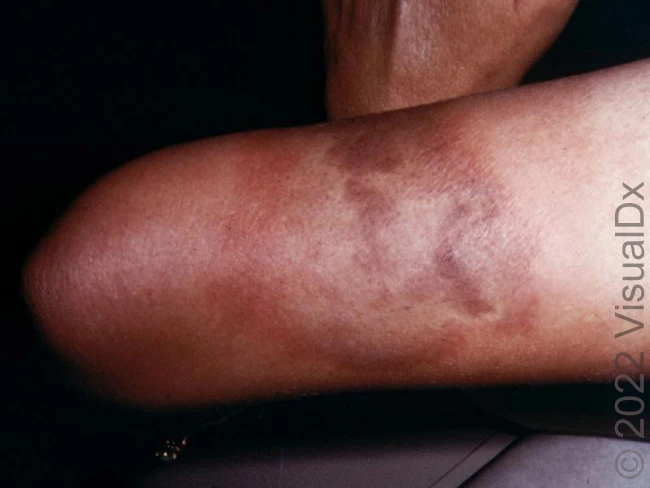
Differential Diagnosis
- Mosquito bite
- Cellulitis
- Erythema migrans
- Recluse spider envenomation
Diagnosis
The correct diagnosis in this case is recluse spider envenomation. Loxosceles spiders are typically brown in color, measure 2-3 cm from leg to leg, and exhibit a dark, violin-shaped spot on the cephalothorax. The initial spider bite is usually painless, however, it may produce a sharp, stinging sensation, and severe burning pain and pruritus develop at the bite site within 2-6 hours.
The incidence of systemic involvement is rare and do not correlate with local findings. As early as 24 hours after envenomation, fever, arthralgias, nausea, vomiting, diarrhea, rash, myalgias, and headache can develop. With more severe systemic illness, hemolysis is the predominant feature. Thrombocytopenia, disseminated intravascular coagulopathy, proteinuria, renal failure, angioedema and death have been reported.
What to Look For
- Over time, the bite wound typically develops an erythematous halo surrounding a central hemorrhagic vesicle. Occasionally, the central vesicle will be surrounded by an area of ecchymosis, surrounded by a ring of pallor and an outer ring of redness.
- In most cases, the lesions at the site of the bite will resolve in a week.
- However, necrosis may form, usually with the hemorrhagic vesicle becoming necrotic with an eschar by day 3-4.
- After 2-5 weeks, the eschar sloughs, leaving an ulcer that often heals by secondary intention, though some may require skin grafting.
- In severe cases, there can be progressive tissue necrosis that is particularly severe in fatty regions such as the buttocks or thighs.
Pearls for Urgent Care Management
- For local effects, use of wound care (ice and elevation) and pain management (acetaminophen and non-steroidal anti-inflammatory drugs) are the mainstay of therapy
- Consider tetanus prophylaxis
- If signs of infection such as erythema, induration or fluctuance, treatment with antibiotics for cellulitis is indicated
- For patients with necrosis or systemic symptoms, transfer to a higher level of care is needed
Download the article PDF: 42-Year-Old With Stinging Sensation
